Video of the Week:
Tips on Harvesting Pears
Turfgrass:
Little Barley in Lawns
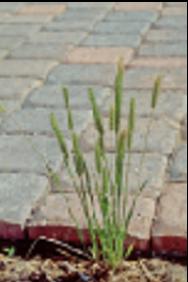
So, why are we talking about little barley now? Because now is the time to control it for next year. The best control for little barley is a thick lawn that is mowed high enough that sunlight does not hit the soil. Little barley seed will not germinate in such conditions. Overseeding now can thicken up a tall fescue lawn and prevent a little barley infestation. However, if you do not plan to overseed, preemergence herbicides can be used to provide at least partial control of this weed.
The only preemergence herbicide that I know is labeled specifically for little barley is Surflan. It is also sold under the name of Weed Impede by Monterey Lawn and Garden. Surflan can only be used on warm-season grasses (bermudagrass, buffalograss, zoysiagrass) and tall fescue grown in warm-season areas such as Kansas. However, Dimension (dithiopyr), is labeled for barley (Herodium spp.) which would include little barley and therefore can be used to keep this weed under control. Because little barley is a winter annual, apply the preemergence herbicide now and water in to activate. If overseeding, do not apply any preemergence herbicide as it will interfere with the germination of tall fescue. (Ward Upham)
Vegetables:
Asparagus and Rhubarb in the Autumn Season
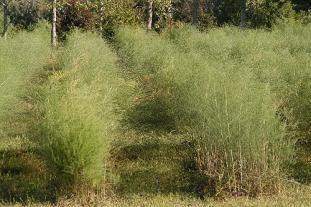
Weird Squash
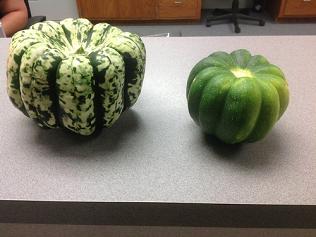
In such cases, the gardener is assuming that cross-pollination will affect the fruit. Such is not the case. The characteristics of the fruit is determined by the mother plant and is not affected by cross-pollination. However, there will be a problem if seed is saved for the next year from a flower that was cross-pollinated. All bets are off on what you will get if that happens.
So, how do we end up with this weird vegetable? Though it could be that the gardener had forgotten exactly what he planted, more likely is that the seed he bought had been accidentally cross-pollinated before packaging. Another possibility is that it came from seed that came from fruit that had rotted in the garden the previous year. Regardless, don’t worry about planting different cultivars of squash or cucumbers or melons close to one another. Though cross-pollination sometimes occurs, the fruit will not be affected. (Ward Upham)
Fruit:
Storing Apples
Wealthy: 60 days
Paulared: 90 days
Gala: 120 days
Jonathan: 120 days
Grimes Golden: 120 days
Golden Delicious: 150 days
Empire:150 days
Delicious: 160 days
Braeburn: 180 days
Idared: 200 days
Rome Beauty: 220 days
Winesap: 220 days
Fuji: 240 days
Granny Smith: 240 days
Arkansas Black: 240 days
The condition of the apples and how they are stored will strongly influence the storage period. Some guidelines to help assure good quality and maximum storage life of apples include:
* Store only the best quality.
* Pick as they are first maturing.
* Avoid skin breaks, disease or insect damage, and bruises on individual fruit.
* Store in a plastic bag to help retain moisture in the apples. The bag should have a few small holes for air exchange. The bags of apples may be stored in boxes to prevent bruising if they must be stacked or moved from time to time.
* Refrigerate at about 35 degrees F. An extra refrigerator works well.
* Sort about every 30 to 40 days to remove fruit that may be beginning to rot. (Ward Upham(-
Ornamentals:
Trees Coloring Early
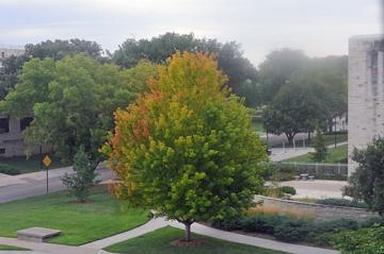
The tree has had plenty of time to store the energy reserves it needs to survive the winter. So, do we need to do anything? Yes, we do. Keep the soil moist as many trees have had root systems damaged from the last couple of years. We need to give that root system time to recover. This is especially important for areas that are still experiencing drought or have had so much rain earlier in the summer that soils were saturated for a period of time. Lack of oxygen from saturated soils is just as damaging to a root system as lack of water. (Ward Upham)
Mycosphaerella Leaf Spot on Ash
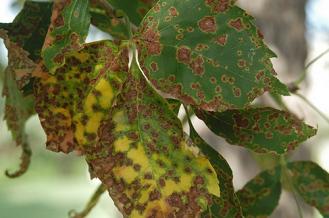
Mycosphaerella leaf spot causes small, brown spots that enlarge to become blotches and may result in early leaf drop. Though this disease looks serious, it is not. Defoliation this late in the growing season will not hurt the health of the tree. Therefore, because this disease appears sporadically and tree health is not harmed, we do not recommend treatment. Furthermore, treatment would have to be preventative and applied before the disease had infected the leaves. Applying a fungicide now would have no effect. (Ward Upham)
Pests:
Emerald Ash Borer Found in Leavenworth County
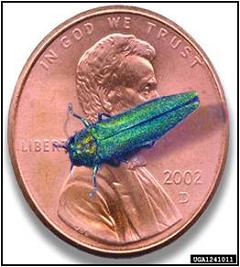
Leavenworth County EAB Find Background - On July 16, 2014, an adult EAB was caught on a girdled tree trap placed on K-5 southeast of Lansing by the Kansas Department of Agriculture (KDA) in cooperation with the Kansas Department of Transportation (KDOT) and the Kansas Forest Service (KFS). A second EAB was also caught on a second girdled trap tree at Kenneth W. Bernard Community Park by KDA in cooperation with the City of Lansing and the KFS. Regulatory officials with the USDA’s Animal and Plant Health Inspection Service’s Plant Protection and Quarantine (USDA-APHIS-PPQ) confirmed the presence of EAB on July 17, 2014.
Immediately after confirmation by USDA, Kansas expanded an emergency intrastate quarantine, currently in place in Wyandotte and Johnson counties, to include Leavenworth County to prevent further spread of EAB in Kansas.
The quarantine applies to any corporation, company, society, association, partnership, governmental agency, and any individual or combination of individuals. It prohibits movement of regulated items from the quarantined area, except under specific conditions established in the
Permanent EAB Quarantine for Wyandotte and Johnson County
Temporary EAB Quarantine for Leavenworth County
Regulated items under quarantine include the following:
* The emerald ash borer, (Agrilus planipennis [Coleoptera: Buprestidae]), in any living stage of development;
* Firewood of all hardwood (non-coniferous) species;
* Nursery stock of the genus Fraxinus (Ash);
* Green lumber of the genus Fraxinus (Ash);
* Other material living, dead, cut, or fallen, including logs, stumps, roots, branches, and composted and uncomposted chips of the genus Fraxinus (Ash);
Any other article, product, or means of conveyance that an inspector determines presents a risk of spreading emerald ash borer and notifies the person in possession of the article, product, or means of conveyance that it is subject to the restrictions of the regulations.
If you suspect emerald ash borer on your property please call 785-862-2180 or e-mail your name, address, phone number and pictures of the suspect tree to ppwc@kda.ks.gov. For answers to common questions, check out our Kansas Emerald Ash Borer Frequently Asked Questions and Do I Have Emerald Ash Borer? (Ward Upham)
Fall Armyworms on Turf
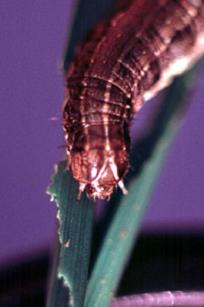
Young worms are ½ to 3/4 inch long. Mature ones are 1 ½ inches long. Body color may vary from green to almost black but light stripes will be visible along the length of the body. Look for a whitish inverted "Y" on the top of the black head. It normally takes 2 to 3 weeks to progress from egg to pupa. The adult is a moth.
Armyworm damage can resemble drought damage but close inspection of the turf will reveal the larvae. Look for active feeding during early morning or evening hours or on cloudy days. Larvae feed on foliage and the resulting dehydration causes to turf to quickly brown. Normally, armyworm damage does not kill established turf.
Carbaryl (Sevin), acephate (Orthene, Acephate), spinosad (Conserve; Captain Jack’s Dead Bug Brew; Borer, Bagworm, Leafminer and Tent Caterpillar Spray) and other insecticides are effective caterpillar killers. Treat in late afternoon, when the caterpillars are likely to begin feeding. Do not mow for 3 days after treatment. (Ward Upham)
Contributors: Ward Upham, Extension Associate
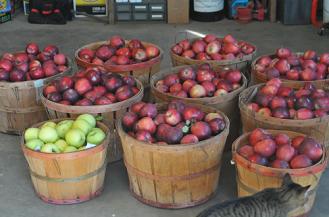
 RSS Feed
RSS Feed
